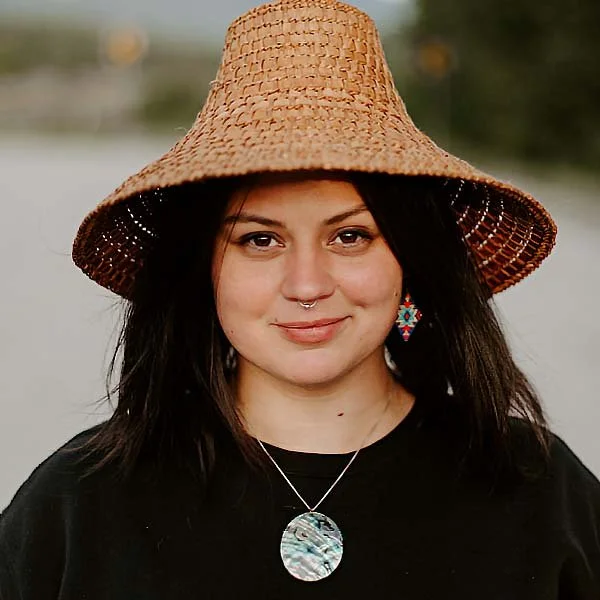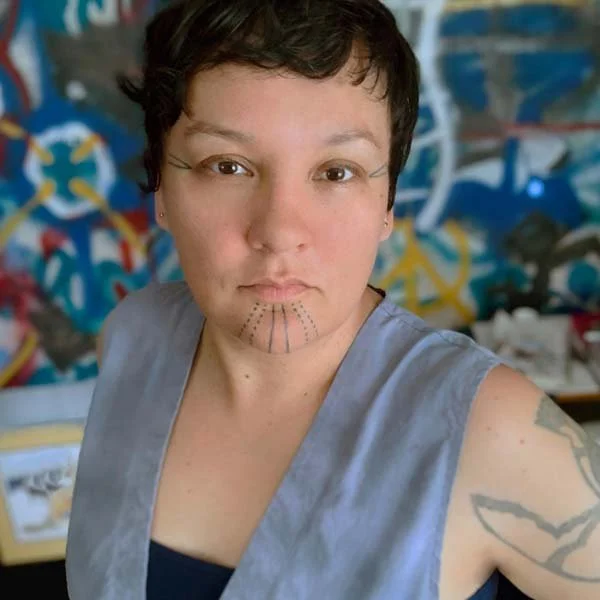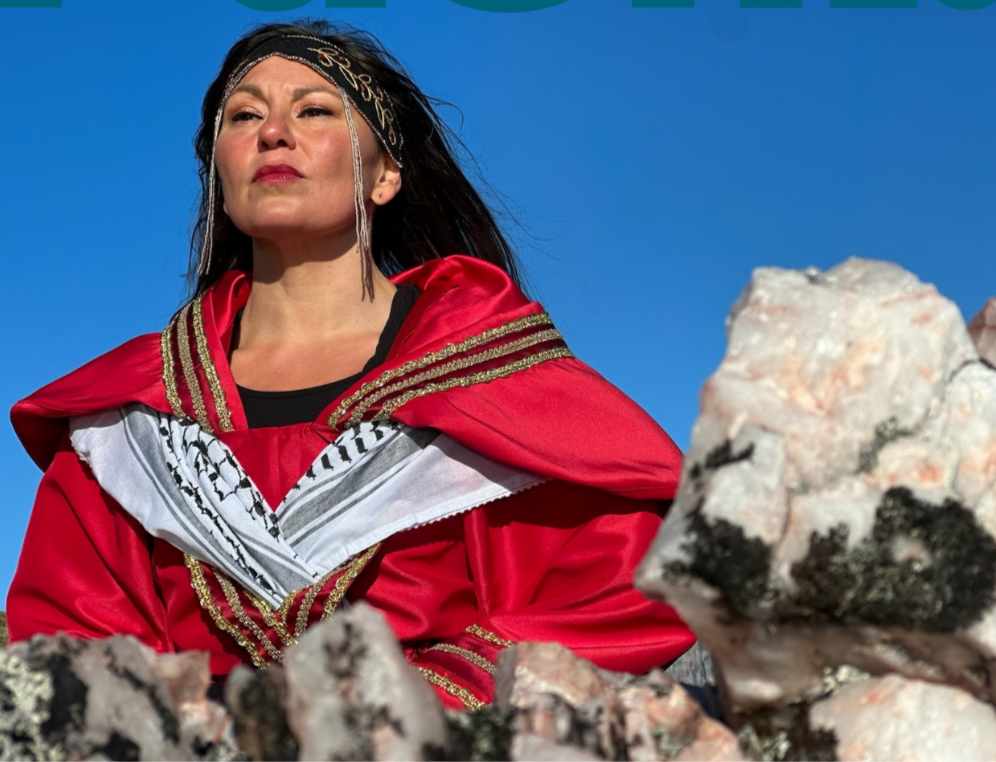sacred skin explores the resurgence of Indigenous tattooing
Talking Stick Festival exhibition highlights seven artists who are revitalizing Indigenous culture through meaningful body markings
Dion Kaszas.
Talking Stick Festival presents sacred skin, co-presented by Full Circle: First Nations Performance and cultural partner SFU Woodward’s Cultural Programs, at SFU Goldcorp Centre for the Arts and online from June 13 to 30
THE MORE AMINA Creighton-Kelly learns about Indigenous tattoo art, the more she is drawn to it. A production associate at Full Circle: First Nations Performance who is of Kanien´kéha:ka, South Asian, British, and French ancestry, Creighton-Kelly views the artform as a visual language of the skin, one that allows culture to be engraved, experienced, and preserved in various individual ways.
The ancient art form was nearly lost through colonization, which sought to erase Indigenous culture as a whole. As Creighton-Kelly continues to delve more deeply into tattooing as a practice and a passion, she wanted to contribute to the current discourse and documentation around the resurgence of traditional Indigenous tattooing in Indigenous communities in present-day Canada and all around the globe.
Creighton-Kelly is the curator of sacred skin, a multifaceted visual-art exhibition featuring the works of seven Indigenous artists that is part of the 2022 Talking Stick Festival.
“In the territory now known as Canada, the practice of this sacred art form was forbidden in 1885 at the same time as the potlatch ban,” Creighton-Kelly says in an interview with Stir. “A decline of many Inuit tattooing practices began with the arrival of Christian missionaries in the Arctic. As with many aspects of Indigenous cultures, much of this knowledge was almost lost due to government suppression.
“The practice of Indigenous tattooing is integrated into the social fabric of life, community, and culture,” she says. “It anchors different values, symbolic rites of passages, connection to ancestors, and sacred ritual and relationships on the skin for all to see. All of this serves to demonstrate Indigenous perseverance.”
Sacred skin explores the resurgence of Indigenous tattooing practices as they relate to cultural revitalization. Each of the seven artists shares an artist statement as well as images and videos of their work. The exhibition will emphasize their individual process of creating a piece: the forms, aesthetics, meanings, and knowledge that they utilize.
There are three main components to the show: An online exhibition; a projection of videos and images of each artist’s work on a loop at SFU Goldcorp Centre for the Arts; and a live demonstration of traditional tattoo processes at SFU GCA on June 14, starting at 6 pm (to be recorded and uploaded to the exhibition page).
“I wanted to highlight and make connections with Indigenous tattoo artists that are involved in the revitalization of ancestral tattooing practices—artists that are passing down knowledge and paving the present as medicine for the future,” Creighton-Kelly says. “I believe this work acts to decolonize notions of art, sacredness, and embedded colonial systems.”
Nakkita Trimble.
Nisga'a Traditional Northwest Coast artist Nakkita Trimble—whose Nisga’a name is Speaking Through Art and whose family is from Kincolith—is among the featured artists in sacred skin. Trimble began practicing tattoo art nearly a decade ago using traditional approaches such as hand-poking and skin-stitching. She is actively involved in tattoo revival for the Nisga’a Nation, viewing the artform as medicine in the face of high suicide rates among Indigenous youth. Her designs are maternal and connected back through generations according to a crest system, binding tattoo recipients to their mothers. For Trimble, her fascination with the art form goes back to childhood.
“I lost my grandmother, ‘mom’, this year, and I remembered recently that I hand-poked her initials into my ankle when I was 11,” Trimble tells Stir. “I did not go deep enough, but it did last for a week or so, and I really think that is when it all began.
“This is one of the oldest professions in the majority of cultures around the world,” Trimble says. “Identity is what anchors young people. To be visible in a society that has done everything to attempt to erase who we are is an important step towards the pride we carry and our duty to uphold for the ancestors who brought us this far. We survived attempted genocide.”
Through a grant from Canada Council for the Arts, Trimble is hoping to create 80 House crest tattoos. For herself, bearing tattoos is to make visible what was already there: her culture. When she practises the art of tattooing, she feels like a conduit for something sacred.
“I honour the privacy of the designs I ink onto people and believe that access and extraction of culture should be respected, especially with the Internet now and issues around appropriation,” Trimble says. “Social media and the Internet lack respect for people’s personal privacy and intellectual property, as well as artist copyright.
“Know your roots,” she says. “Know your culture. Celebrate who you are no matter where that is from.”
Holly Mititquq Nordlum.
Holly Mititquq Nordlum, who’s also featured in sacred skin, is an Iñupiaq (Inuit) artist who grew up in and outside of the northern village of Kotzebue, Alaska. Her revitalization of tattoo work and traditional markings is a machine-free process that facilitates healing from the traumas of colonization and individual experience while fostering pride and celebration. It is based on a 10,000-year Inuit history.
“I was attracted to traditional tattooing because my great grandmother had them,” Nordlum tells Stir. “My mom was named for her and I always had an interest. I have been an artist for 20 years and wanted to do something besides call out the issues in our community. I wanted to do something positive and bring healing or change to my people.”
With a bachelor of fine arts from the University of Alaska, Nordlum has, in the last five years, received a Time Warner Fellow with Sundance, an Art Matters grant and a Alaska Humanities Forum grant, an Alaska Native Visionary Award, and a Rasmuson Artist Project Grant, among other honours. She has also been part of Smithsonian’s NMAI’s Artist Leadership Program. She explains that traditionally, most Inuit tattoos were done with simple tools and consisted of lines, dots, and circles. “You have to consider our availability and our climate when thinking about what we were working with,” Nordlum says. “Inuit people are in the Arctic and most of our lives were concerned with food and shelter.”
Nordlum says that while she feels thankful to be practising the art form at a time when more people are helping keep it alive and move it forward, she says there is much more work to be done on a broader scale.
“How I feel doing the work that I do is grateful—grateful that there is this movement and grateful that I get to be a part of it and connect to generations of my people,” she says. “That said, I’m equally frustrated with the rest of the world as we fight appropriation constantly, that non-Indigenous people will just take what they think is exotic from us and not consider the detrimental effects of stealing and hindering our healing. This is an exclusive practice for us as Inuit, and it is sacred. We are still the other, and racism is an everyday reality in each country that colonized us.
“There is so much to say about our attempted genocide and the resilience of our people in every country we reside, that traditional markings are just one facet of the renaissance of our people and it only gets attention because it is ‘exotic’ in the eyes of the outsider,” Nordlum says. “But we are much more and our culture is much more, and we are trying to find our way back to something that helps us navigate the world we find ourselves in, a world that marginalizes and subjugates us. We are now in the process of doing the work ourselves and no longer need or want a savior.”
It is important for Nordlum to do tattoos because it makes a difference for her people. “They leave my studio and walk the world with markings that are visible and remind the rest of the world that we are still here and thriving despite the attempted genocide,” Nordlum says. “They also have to walk with pride and are a bit stronger for it.”
Dion Kaszas.
The other artists being showcased in sacred skin are multi-disciplinary Métis artist Audie Murray and Dion Kaszas, a Nlaka’pamux ancestral embodied mark maker who has been featured everywhere from The World Atlas of Tattoo and The New York Times to Skindigenous, a 13-part documentary series and the FOX series USA Ink. GiG – K’aajuu G’aaya has his own ship in Daajiing Giids on Haida Gwaii called Haida Inkk and has been a guest artist at several respected spots, including Liquid Amber Tattoo & Art Collective in Vancouver. Nahaan (whose matrilineal lineage is of the Tlingit; whose grandfather is Iñupiaq; whose biological father of the Paiute; and whose actual father is of the Kaigani Haid) focuses exclusively on working within the spirit and design style of the Northwest Coast practices and customs of ceremonial tattooing. Nicole Neidhardt, who is Diné (Navajo) of Kiiyaa’áanii Clan on her mother’s side and a blend of European ancestry on her father’s side, is currently based in Santa Fe, New Mexico, where she incorporates hand-poke tattooing into her multidisciplinary practice.
Creighton-Kelly has been practicing tattooing over the last several years using both a machine as well as hand-poking methods. She began by tattooing herself as her main canvas for practice and has gone on to tattoo many friends and family.
“I find much solace in this process of self-expression, discovery, and learning,” Creighton-Kelly says. “I love this artform for so many reasons. I love the history behind it, the taboos against it, and the diversity of people involved in the contemporary cultures of tattooing.
“There are undeniable connections that this practice offers—connection to ancestors, to land, to kin, to self, to one another,” she shares. “This aspect of connection has been a huge draw for me. There is also a depth and complexity within this artform that profoundly intrigues me.”
Creighton-Kelly shares that among the media she has explored as an artist, tattooing has been the most powerful in enabling her to evolve her sense of identity and her connection to the body. It has also been healing.
“I love the notion of being a concrete embodiment of one’s art and I’m focused more than ever on how this art form can be an act of decolonizing oneself,” Creighton-Kelly says. “I have encountered a deep sense of reciprocity within this art form–one that has nurtured new relationships, understandings, and opportunities for which I am so grateful.
“Building community, connection, and care is at the center of this work for me,” she adds. “Often when I tattoo someone, there is an exchange that occurs – whether it be an exchange of art, stories, or teachings. Each Experience grounds me in new ways. Tattooing has really been a form of medicine for me."
















